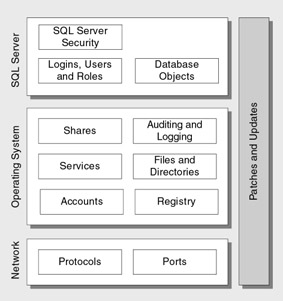Methodology for Securing Your Server
Securing SQL Server and Windows 2000 involves many configuration changes. The best approach is to separate the changes that must be made into specific configuration categories. Using categories allows you to systematically walk through the securing process from top to bottom or pick a particular category and apply specific steps.
Configuration Categories
The securing methodology has been organized into the categories shown in Figure 18.2.

Figure 18.2: Database server security categories
The configuration categories shown in Figure 18.2 are based on best practices obtained from field experience, customer validation, and the study of secure deployments. The rationale behind the categories is as follows :
-
Patches and Updates
Many security threats exist because of vulnerabilities in operating systems, services, and applications that are widely published and well known. When new vulnerabilities are discovered , attack code is frequently posted on Internet bulletin boards within hours of the first successful attack. Patching and updating your server's software is the first step toward securing your database server. There may be cases where a vulnerability exists and no patch is available. In these cases, be aware of the details of the vulnerability to assess the risk of attack and take measures accordingly .
-
Services
Services are prime vulnerability points for attackers who can exploit the privileges and capabilities of the service to access the server and potentially other computers. Some services are designed to run with privileged accounts. If these services are compromised, the attacker can perform privileged operations. By default, database servers generally do not need all services enabled. By disabling unnecessary and unused services, you quickly and easily reduce the attack surface area.
-
Protocols
Limit the range of protocols that client computers can use to connect to the database server and make sure you can secure those protocols.
-
Accounts
Restrict the number of Windows accounts accessible from the database server to the necessary set of service and user accounts. Use least privileged accounts with strong passwords in all cases. A least privileged account used to run SQL Server limits the capabilities of an attacker who compromises SQL Server and manages to execute operating system commands.
-
Files and Directories
Use NTFS file system permissions to protect program, database, and log files from unauthorized access. When you use access control lists (ACLs) in conjunction with Windows auditing, you can detect when suspicious or unauthorized activity occurs.
-
Shares
Remove all unnecessary file shares, including the default administration shares if they are not required. Secure any remaining shares with restricted NTFS permissions. Although shares may not be directly exposed to the Internet, a defense in depth strategy with limited and secured shares reduces risk if a server is compromised.
-
Ports
Unused ports are closed at the firewall, but it is required that servers behind the firewall also block or restrict ports based on their usage. For a dedicated SQL Server, block all ports except for the necessary SQL Server port and the ports required for authentication.
-
Registry
SQL Server maintains a number of security- related settings, including the configured authentication mode in the registry. Restrict and control access to the registry to prevent the unauthorized update of configuration settings, for example, to loosen security on the database server.
-
Auditing and Logging
Auditing is a vital aid in identifying intruders, attacks in progress, and to diagnose attack footprints. Configure a minimum level of auditing for the database server using a combination of Windows and SQL Server auditing features.
-
SQL Server Security
A number of SQL Server security settings can be controlled through Enterprise Manager. These include the authentication mode, auditing level, and the accounts used to run the SQL Server service. For improved security, you should use Windows authentication. You should also enable SQL Server logon auditing and ensure that the SQL Server service runs using a least privileged account.
-
SQL Server Logins, Users, and Roles
SQL Server 2000 manages access control using logins, databases, users, and roles. Users (and applications) are granted access to SQL Server by way of a SQL server login. The login is associated with a database user and the database user is placed in one or more roles. The permissions granted to the role determine the tables the login can access and the types of operations the login can perform. This approach is used to create least privileged database accounts that have the minimum set of permissions necessary to allow them to perform their legitimate functionality.
-
SQL Server Database Objects
The ability to access SQL Server database objects, such as built-in stored procedures, extended stored procedures and cmdExec jobs, should be reviewed. Also, any sample databases should be deleted.
EAN: 2147483647
Pages: 613
- Challenging the Unpredictable: Changeable Order Management Systems
- The Effects of an Enterprise Resource Planning System (ERP) Implementation on Job Characteristics – A Study using the Hackman and Oldham Job Characteristics Model
- Distributed Data Warehouse for Geo-spatial Services
- Intrinsic and Contextual Data Quality: The Effect of Media and Personal Involvement
- Relevance and Micro-Relevance for the Professional as Determinants of IT-Diffusion and IT-Use in Healthcare